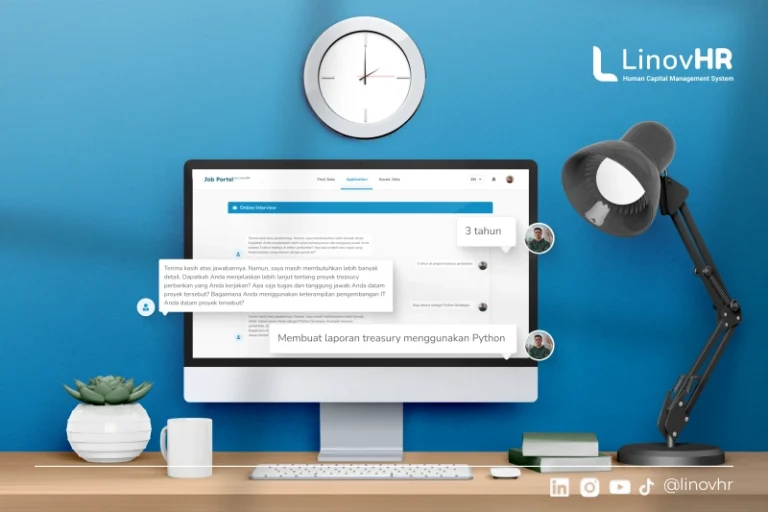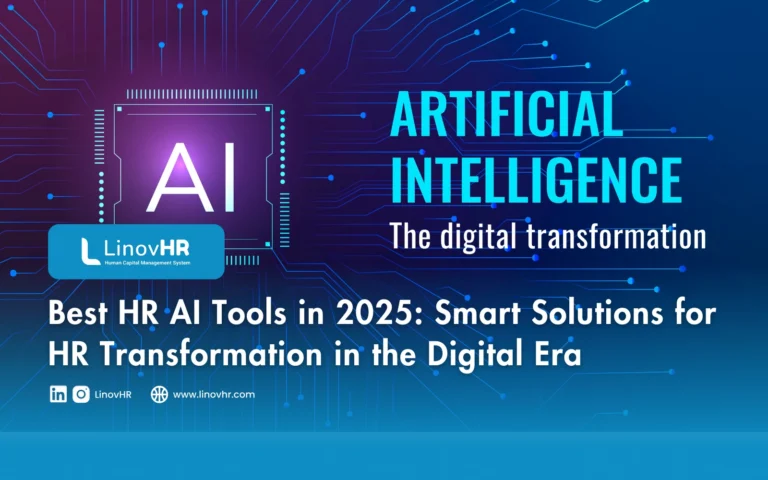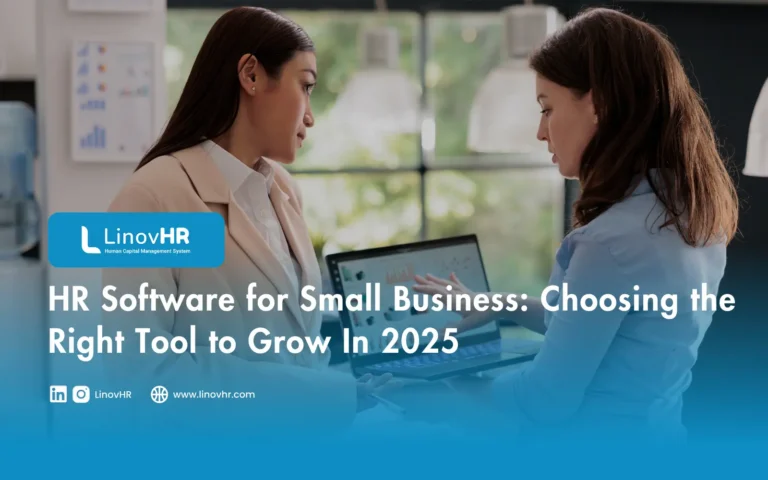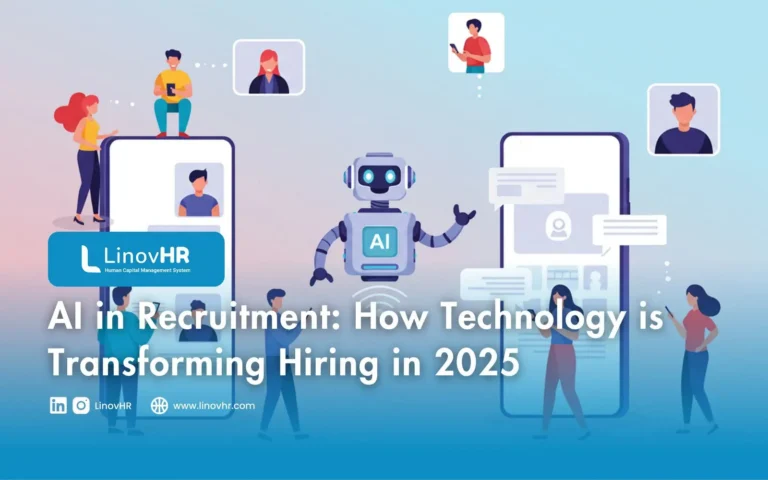In today’s fast-paced digital transformation era, the Human Resources (HR) function is no longer just about administrative management, recruitment, or payroll operations.
Technologies such as AI in HR have now penetrated core HR processes, from recruitment, onboarding, employee development, to workforce planning predictions.
By leveraging smart algorithms, machine-learning, and analytics systems, HR teams can transform their role into a strategic business partner that delivers greater value.
This article will comprehensively discuss: what AI in HR, the benefits it brings, challenges to anticipate, best practices for implementation, and how LinovHR can help your organization begin the AI in HR Transformation journey with confidence.
What Is AI in HR?
In this section, we explain the definition and scope of AI in HR so readers can understand the basic framework before diving into benefits, challenges, and implementation.
AI in HR refers to the use of intelligent technologies, such as machine-learning, natural language processing (NLP), predictive analytics, and generative AI,to support, accelerate, or automate function within the HR department.
For example, AI in HR systems can analyze thousands of resumes in seconds, predict employee turnover risks, provide development recommendations, and power employee service chatbots.
Its scope of AI in HR solutions is very broad, covering talent acquisition, onboarding, performance management, learning & development, workforce planning, and daily employee experience. In other words, AI in HR is not just an additional tool, but increasingly an integral part of strategic HR operations.
For instance, many routine functions that previously consumed significant time can now be handled by AI in HR automation, enabling HR to focus on more meaningful human interactions.
Also read: Best HR AI Tools in 2025: Smart Solutions for HR Transformation in the Digital Era
Benefit of Implementing AI for HR
Before diving deeper, implementing AI in HR technology is not just about technology, it’s about aligning that technology with HR and business strategy as a whole. Here, we discuss three primary benefits of AI in HR implementation.
1. Efficiency & Productivity
One of the most evident benefits of Ai in HR platforms is improving operational efficiency and team productivity.
With AI in HR automating repetitive administrative tasks (such as CV screening, answering employee questions via chatbots, automated scheduling), administrative workloads can be greatly reduced.
For example: an AI in the HR system can process hundreds of job applications and instantly produce a shortlist of qualified candidates, instead of HR manually sorting them one by one.
The result: HR teams gain more time for strategic initiatives such as talent management, culture development, and employee experience, not just “putting out fires” in admin work.
2. Data-Driven Decision Making
Beyond efficiency, AI in HR analytics enables HR to make decisions based on data. By collecting and analyzing employee data, AI in HR software helps HR identify trends, predict workforce needs, measure HR program effectiveness, and plan with greater precision.
Example: using AI in HR predictive models, HR teams can identify turnover risks within the next 6 months, then prepare proactive interventions.
This allows HR to be proactive, capturing opportunities and reducing risks before they escalate into crises.
3. Better Employee Experience
AI in HR applications enables personalization across multiple employee touchpoints: from application, onboarding, learning & development, to daily HR service interactions.
For example: chat bots available anytime, automated learning systems recommending personalized training modules, or smoother onboarding experiences. When employees feel AI in HR makes HR Fast, responsive and relevant satisfaction and engagement rise. This supports talent retention and helps build a positive work culture.
Challenges and Risks to Watch Out For
While the benefits are significant, AI in HR also demands organizations to remain cautious about key challenges and risks. This section covers three major areas.
1. Algorithms Bias & Transparency
One of the most critical risks in AI in HR technology is algorithmic bias and lack of transparency. Poorly designed and tested AI systems can replicate or even amplify human biases for example in hiring or promotion decisions.
Example: research shows AI in HR screening tools have at times ranked candidates based on biased criteria such as name or gender.
Additionally, many AI systems operate as “black boxes”. HR or end users may not understand how decisions or recommendations are produced, leading to issues with trust and accountability.
Mitigation includes: data audits, awareness of bias, and adoption of “explainable AI” (XAI) so HR can clearly interpret and articulate system outputs.
2. Data & Infrastructure Readiness
Implementing AI in HR is not merely purchasing software, adequate data preparation and infrastructure are essential. HR data often sits in fragmented systems or lacks quality, which hinders optimal AI in HR results.
IT infrastructure must support integration, data security, and potentially 24/7 operation. Without a strong foundation, AI projects risk staying stuck as pilots that never deliver true business value.
Organizations must therefore prioritize data cleansing, HR system integration, and regulatory compliance (privacy, security) to ensure successful AI in HR implementation.
3. The Human Role in the AI Era
Even with automation and intelligence, the human role, especially HR remains essential. Common concerns include fears that AI will replace jobs, the shift in HR roles from operational to strategic, and cultural adaptation to new ways of working.
HR must act as a change manager and communicator in AI in HR transformation to ensure trust and adoption among employees. . The “authentically human” aspect of HR ensures technology enhances, not hinders, human relationships.
Poor human involvement can lead to resistance, misunderstandings, and trust issues among employees.
Best Practices for Implementing AI in HR
To ensure smooth implementation and impactful outcomes, here are best practices organizations can follow.
1. Setting an AI Vision & Business Goals
Before choosing tools or vendors, organizations must set a clear vision: What is the purpose of AI in HR? To accelerate recruitment? Improvement retention? Optimize labor costs? Enhance employee experience? Align it with broader business strategies.
Without a clear vision, AI in HR projects risk becoming “experiments without results.” research also indicates that AI-based HR transformation requires changes in work models and workflows, not just technology.
Commitment from HR leadership and top management is essential, ensuring resources, communication, and cultural readiness.
2. Improving Data & Infrastructure Readiness
Once vision and business goals are defined, the next step is ensuring data and infrastructure readiness so AI can perform optimally.
This begins with ensuring HR data quality, completeness, and accuracy, as algorithms work only as well as the data they are fed. Organizations must also integrate various disparate systems to allow smoother data flow and prevent information silos.
In addition, data security and privacy compliance must be top priorities, as HR data is highly sensitive. During initial deployment, organizations should start with pilot projects focused on strategic use cases to enable learning before scaling up AI initiatives.
With a strong data and infrastructure foundation, AI investments can deliver real value to HR and overall business objectives.
3. Upskilling HR Teams & Change Management
Despite rapid technological advancements, successful AI implementation depends heavily on the readiness of the people operating it. Hence, upskilling HR teams is crucial.
HR must understand how AI works, how to interpret data analytics, and how to leverage system recommendations in decision-making.
Organizations must also promote cultural adaptation through clear communication so employees understand AI benefits and do not perceive it as a threat.
With proper change management, AI becomes a tool for empowering talent, not replacing humans. Continuous training, leadership involvement, and ongoing evaluation ensure long-term, widely accepted AI adoption.
Also read: AI in Recruitment: How Technology is Transforming Hiring in 2025
LinovHR Helps Organizations Adopt AI in HR
LinovHR is ready to support companies in their digital transformation journey through AI adoption in HR.
From mapping data and infrastructure readiness, identifying the right AI use cases, to providing strategic consulting and implementation support, all can be tailored to your business goals and needs.
LinovHR also helps develop HR team capabilities through training and workshops so they can adapt to technological shifts and optimize their role in an increasingly data-driven organization.
If you are ready to take real steps toward a more modern and efficient HR function, contact LinovHR for a consultation session and request a free demo as the first step toward AI transformation in your organization.







